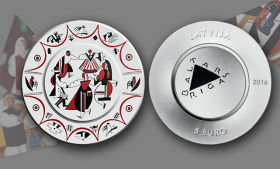Banks, Culture, Financial Services, History, Latvia, Markets and Companies, Society
International Internet Magazine. Baltic States news & analytics
Saturday, 31.05.2025, 08:19
Bank of Latvia to issue more collector coins Baltars Porcelain next week
 Print version
Print version |
|---|
Starting 10 a.m. Monday, October 10, the coin can also be reserved via the collector coin and other numismatic product online reservation service under the Banknotes and Coins Section of the Bank of Latvia website. The reservation limit is one coin.
As many as 400 coins will be available at the reservation service and 1,000 will be sold at the central bank's offices in Riga and Liepaja.
As reported, the Bank of Latvia issued a EUR 5 silver collector coin of a unique shape - Baltars. Porcelain - on August 9. The price of the coin at the Bank of Latvia's cashier offices was EUR 53. The maximum mintage of the coin was limited to 5,000.
The first 300 collector coins that were issued in August were sold out quickly, in just a few hours.
The coin dedicated to Baltars, the workshop of fine china and faience painting, the pride of Latvian national culture, has been designed by reproducing the image of the plate Dance (Romans Suta was the author of the composition; 1927) and in the shape of a plate.
The graphic design of the collector coin Baltars. Porcelain, which is a miniature piece of art, was created by artist Franceska Kirke. The coin has been minted by UAB Lietuvos Monetu Kalykla (Lithuania). The graphic mark of Baltars is depicted on one side of the coin; the other side features the reproduction of the plate Dance by Suta. The coin has been struck in the shape of a flat plate.
One of the greatest art treasures in the Latvian Cultural Canon is the impressive achievements of Baltars, the workshop where fine china was artistically painted in the 1920s. Baltars resulted from the idea of the Latvian painter, graphic artist and composition virtuoso Romans Suta (1896-1944) to create a cultural milieu corresponding to the era of modernism and its language of form. His intent mostly focused on interior design and applied arts where decorative ceramics was supposed to work as a peculiar accent of functionalist and constructivist aesthetics and ideology. The masterpieces of decorative art made at Baltars matched the quality of the highest achievements of Art Deco and have become the pride of Latvian national culture.
The collector coin Baltars. Porcelain is legal tender in the Republic of Latvia, yet the release of such coins in circulation is highly unlikely, as they are in fact works of art and are in special demand among coin collectors and other interested parties.








 «The Baltic Course» Is Sold and Stays in Business!
«The Baltic Course» Is Sold and Stays in Business!

